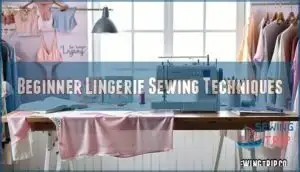This site is supported by our readers. We may earn a commission, at no cost to you, if you purchase through links.
 You can buy a dozen variations of the same mass-produced bra, or you can make one that actually fits your body. DIY lingerie puts you in control of every seam, every strap, and every choice that touches your skin. No more settling for cups that gap or bands that dig in.
You can buy a dozen variations of the same mass-produced bra, or you can make one that actually fits your body. DIY lingerie puts you in control of every seam, every strap, and every choice that touches your skin. No more settling for cups that gap or bands that dig in.
When you sew your own pieces, you decide the fabric weight, the elastic tension, and where the lace sits. You’re not following someone else’s template for what lingerie should be—you’re building something that moves with you.
The techniques are simpler than you think, and the freedom that comes with creating your own intimate wardrobe is worth every stitch.
Table Of Contents
Key Takeaways
- Making your own lingerie gives you complete control over fit, fabric choices, and comfort while eliminating the frustration of mass-produced pieces that gap, dig in, or don’t match your body’s unique shape.
- The essential foundation includes stretch lace, mesh, proper elastics (picot for edges, band for support), and basic sewing tools like ballpoint needles and zigzag stitches that move with stretch fabrics instead of breaking.
- Beginner-friendly projects like simple panties and bralettes teach core techniques—attaching elastic without puckering, sewing stretch seams that won’t snap, and creating adjustable straps—before advancing to structured pieces like corsets or underwire bras.
- Personalization through embellishments, sustainable fabric choices, and refashioning old pieces transforms DIY lingerie from basic sewing into creative expression that reduces waste while building garments perfectly suited to your preferences.
Essential Tools and Materials for DIY Lingerie
Before you cut your first piece of lace or thread your machine, you need the right materials and tools on hand. The difference between a DIY win and a frustrating mess often comes down to using fabrics that stretch the way lingerie should and notions that won’t snap after one wear.
Here’s what you need to gather before you start sewing.
Choosing Lingerie Fabrics and Lace
The fabric you choose becomes the foundation of comfort, fit, and durability in every piece you make. Here’s what works best for lace underwear and lace bras:
- Stretch lace fabric – moves with your body and doesn’t restrict
- Mesh and tulle – breathable base layers for support
- Satin or silk knits – smooth against skin with natural give
- Cotton jersey blends – everyday comfort that lasts
Match your fabric types to how you’ll wear the piece.
Selecting Elastics, Notions, and Hardware
Once you’ve chosen your fabric, the right elastic and hardware will make or break how your piece actually fits and holds up over time.
Picot elastic works beautifully along leg openings for a delicate finish. Band elastic provides firm support at bra underbands without digging in.
You’ll also need strap adjusters for bralettes and bra closures like hook-and-eye tape. Match your elastic attachment method to your fabric weight and stretch.
Recommended Sewing Tools for Beginners
Having the right tools on hand lets you work quickly and cleanly without fighting your fabric. Start with a basic sewing machine that manages stretch stitches. Sharp fabric cutters and measuring tools keep your cuts precise. Use ballpoint sewing needles designed for knits to prevent snags. Quality thread types that stretch with your fabric prevent breakage.
Many sewing kits bundle these sewing supplies together, making it easy to follow sewing patterns and master essential sewing techniques.
Sourcing Sustainable and Eco-Friendly Materials
You can make ethical fashion choices that feel good and do good. Organic cotton, recycled textiles, and sustainable lace from natural fibre fabric reduce your environmental footprint. Look for eco fabric options like TENCEL or viscose from bamboo as green materials that breathe beautifully.
Sustainable lingerie options help you honor your body while reducing fabric waste. These sustainable materials work just as well as conventional supplies. By choosing materials with eco friendly practices, you can further minimize your environmental impact.
Beginner Lingerie Sewing Techniques
Learning lingerie techniques opens the door to making pieces that fit you perfectly. Master these basics and you’ll be ready to tackle any project in this guide.
The four essential skills below will get you started with confidence.
Attaching Elastic to Lingerie
Learning to attach elastic properly is what separates homemade underwear from underwear that actually stays put. You have three main elastic types to work with: picot elastic for delicate edges, foldover elastic for quick binding, and band elastic for waistbands. Each brings different stretch and support.
Choose your method based on what feels right:
- Picot elastic creates those soft scalloped edges that won’t dig in
- Foldover techniques let you skip hemming entirely and finish raw edges fast
- Stretch binding wraps fabric edges for a clean professional look
- Waistband construction with band elastic keeps everything secure without rolling
Sewing Seams for Stretch Fabrics
When you’re working with stretch fabric, everything changes. Your standard straight stitch will snap the moment you pull on a seam. That’s why zigzag stitch becomes your best friend—it moves with the fabric instead of fighting it.
Set your sewing machine to a narrow zigzag or use a stretch stitch if available. Test your seam allowance and elastic thread choices on scraps first. These sewing techniques and seam finishing methods protect your work from popping open.
Using a ball point needle can prevent skipped stitches.
Creating Adjustable Straps
Adjustable straps let you dial in the perfect fit without settling for one-size-fits-all frustration. Thread your elastic or strap materials through sliders/adjusters—those small metal or plastic buckle types that let you shorten or lengthen as needed. Weave the sewing elastic back through the second opening to lock it in place.
Different closure systems give you control over strap length and comfort.
Tips for Cutting Delicate Fabrics
Delicate fabrics like lace and silk won’t forgive a rushed cut—one slip and you’ve turned a 20-dollar-a-yard treasure into scrap confetti. Sharp rotary cutters or fabric shears give you precision cutting without snagging lace fabric or stretch fabric.
Pin inside seam allowances where holes won’t show. Use pattern making weights instead of pins when possible.
Keep your cutting tools clean and test your sewing machine tension on scraps before committing to your final piece.
Step-by-Step DIY Panties and Thongs
Making your own panties puts you in control of fit, fabric, and style. These tutorials walk you through basic panty construction, creative refashioning projects, and special designs that push boundaries.
Whether you’re starting from scratch or transforming what’s already in your drawer, you’ll find clear steps to make something uniquely yours.
Make Your Own Panties Tutorial
Sewing your first pair of panties might feel like a leap into the unknown, but it’s actually one of the most beginner-friendly lingerie projects you can tackle. Start with a simple DIY pattern and choose stretchy fabric like cotton jersey or lace.
Basic sewing tips include using a zigzag stitch and letting elastic guide your seams. These underwear sewing projects teach you foundational lingerie hacks while creating something uniquely yours.
Turn Old Panties Into Thongs
If you’ve got a drawer full of panties that sit a little too high or just don’t spark joy anymore, you can give them a rebellious second life with nothing more than scissors and a few minutes of courage. This upcycling lingerie hack transforms boring underwear sewing projects into custom thong-style options without starting from scratch.
Quick thong tutorial essentials:
- Cut away the back fabric, leaving panty elastic reuse intact
- Keep the gusset fabric choice centered for comfort
- Use pattern alterations guide principles to adjust fit
- Finish raw edges with a zigzag stitch or fold-over elastic
Your DIY lingerie adventure starts with one bold snip.
Edible and Lace Panty Projects
When you’re ready to push the boundaries of playful and provocative, edible underwear and delicate lace panties let you turn a simple sewing project into something memorable.
Edible Panty Recipes use candy wafers or fruit leather, while lace underwear demands careful Lace Sourcing Ethics and Allergen-Free Options.
Tatted Lace Panties and lace shorts offer heirloom-quality Novelty Panty Designs worth the effort.
Finishing Touches for Custom Panties
A perfectly sewn panty can still look unfinished if the edges fray or the elastic puckers, so these final steps separate a wearable piece from something you’re proud to show off.
Trim excess threads and press folded seams flat. Test your elastic tension before topstitching the waistband. Apply lace trim along leg openings for a polished edge.
- Panty hemming: Use a zigzag stitch on stretch fabrics to prevent puckering and maintain flexibility.
- Waistband tips: Pin elastic evenly and stretch as you sew, ensuring consistent tension across the entire band.
- Panty linings: Add cotton gussets for comfort and durability when sewing lace underwear or delicate undies.
How to Make Custom Bras and Bralettes
Making your own bras and bralettes puts you in the driver’s seat regarding fit and style. Whether you’re starting from scratch or breathing new life into something you already own, these projects give you control over every detail.
Here’s how to create custom pieces that actually work for your body.
DIY Bralette Step-by-Step
Building your first bralette feels like crossing a threshold—you’re no longer just fixing what’s broken but creating something that fits your body exactly the way you want it to.
Start with simple bralette patterns designed for wireless bralettes using stretch lace or soft lingerie fabrics. Cut your pieces carefully, then assemble the cups and band following sewing lingerie patterns that guide you through attaching custom straps and elastic.
Basic bra fitting knowledge helps you adjust before the final seam.
Refashion an Old Bra
Your favorite old bra that no longer fits right doesn’t have to retire—it can become the foundation for something completely new. Strip it down by removing the straps and adjusting elastic, then rebuild using sewing lingerie patterns and fresh lace.
Bra upcycling breathes life into worn pieces, transforming a basic bra into sustainable bras that feel custom-made. Eco lingerie starts with what you already own.
Bra Bandeau and Halter Styles
Bandeau and halter styles strip away the usual straps and underwire, giving you a fresh canvas to build strapless support or bold necklines that wrap around like you mean it.
A bra bandeau stays put with grippy elastic along the band, while a halter bra ties or hooks behind the neck for drama.
Experiment with bra closure options like hook-and-eye or adjustable ties, then layer on lingerie embellishments for edge.
Adjusting Fit and Support
Support starts with the band gripping at 90 percent of your underbust measurement.
For Bra Fitting precision, test each cup adjustment by checking for gaping or spillage across underwire bras and soft-cup styles alike.
Adjusting bra straps and elastic tension shifts lift, while power bars inside add structure for custom fit and comfort.
Slash-and-spread sewing techniques redistribute volume, turning generic patterns into support systems customized to you.
Creative Lingerie Projects and Personalization
Once you’ve mastered the basics, it’s time to break free from the standard patterns and make something entirely your own.
This section covers projects that go beyond simple bras and panties. From garter straps to full corsets, you’ll find ways to add drama and personal flair to everything you create.
Make Garter Straps and Bands
Garter straps transform lingerie from pretty to provocative in one swift click. You need elastic bands, adjustable clips, and fabric to match your bra or panty set.
Start by cutting band elastic to fit your waist comfortably. Sew elastic to lingerie using a zigzag stitch to keep stretch intact. Attach strap adjusters and clips for that perfect length every time.
Lace Shorts and One Piece Lingerie
Lace shorts blur the line between sleepwear and statement piece, giving you coverage that feels like confidence wrapped in sheer rebellion. Use lace trim along hems for that boudoir fashion edge. One piece lingerie takes your sewing skills further by combining top and bottom into unified intimacy.
Tips for lace shorts and one piece designs:
- Match lace trim to elastic waistbands for cohesive lingerie sets
- Choose stretch lace for one piece lingerie that moves with you
- Add decorative bows or ribbons at center front for personalization
- Layer sheer lace over opaque fabric for adjustable coverage
Corset and Bodysuit Tutorials
Corset fitting transforms fabric into armor, demanding precision in garment construction and patience with boning channels. Sewing corsets requires stable fabrics like coutil, while bodysuits need four-way stretch and clean seam finishes. Start with beginner-friendly bodysuit patterns before tackling structured corsets—bodysuits teach you lingerie draping and stretch fabric control. Practice garment making fundamentals on bodysuits before attempting complex lingerie making projects like corsets.
| Garment Type | Key Sewing Techniques | Recommended Materials |
|---|---|---|
| Structured Corset | Boning insertion, grommets, lacing | Coutil, steel boning, twill tape |
| Fashion Corset | Decorative stitching, lighter boning | Brocade, spiral boning, lace overlay |
| Basic Bodysuit | Snap application, crotch seams | Stretch mesh, jersey knit, FOE |
| Lace Bodysuit | Seam stabilization, underlining | Stretch lace, power mesh lining |
| Longline Corset | Waist shaping, multi-panel construction | Heavy satin, flat steel boning, grosgrain |
Adding Embellishments and Personal Touches
Embellishments turn plain pieces into showstoppers—think of them as the secret weapon that lets your personality shine through every stitch. Custom lingerie demands sewing techniques that balance delicate fashion design with secure attachment methods for bead embellishments and appliqué techniques.
- Embroidery designs add texture without bulk when worked on stable mesh
- Fabric dyeing transforms basic materials into one-of-a-kind colorways
- Monogrammed hardware like monogrammed rings elevates DIY lingerie from homemade to couture
Practice weaving ribbons through eyelets before tackling complex lingerie-making projects.
Frequently Asked Questions (FAQs)
What are the benefits of making your own lingerie?
Making your own lingerie means custom fit that flatters your shape. You’ll save money while cutting textile waste.
DIY lingerie lets you express personal style and embrace body positivity through sewing intimate apparel at home, choosing sustainable fashion over mass production.
What materials do I need to make lingerie?
Picture silk slipping through fingers like water.
Fabric selection includes stretch lace types, picot elastic, power mesh for support, cotton knit fabric for comfort panels, notions like hooks and rings, plus coordinating thread colors.
What are some tips for making lingerie?
Start with accurate lingerie patterns and take careful measurements.
Practice sewing techniques on scraps before cutting delicate fabrics.
Focus on fabric choice and fitting techniques to guarantee comfort and support in your DIY bra making.
Where can I find patterns and tutorials for making lingerie?
You’ll discover lingerie patterns and sewing tutorials through Instructables, which offers step-by-step DIY guides with pictures.
Madalynne Intimates provides patterns and online courses, while crafting communities like r/MAKEaBraThatFits share free patterns and techniques for sewing lingerie at home.
What is the typical cost of DIY lingerie supplies?
Fabric prices range from $8 to $25 per yard, while lace costs $5 to $ Elastic expenses run $2 to $8 per yard. Complete lingerie sewing kits cost $15 to $50, offering material savings over buying individual supplies.
How do you determine proper sizing for lingerie?
Think of your body as a blueprint. Take full body measurements: bust, underbust, waist, hips. Compare them against sizing charts from lingerie patterns.
Fit analysis helps you adjust pattern making. For bras, use size calculations combining band and cup measurements. Always account for elastic stretch in sewing techniques.
Can beginners make underwire bras at home?
Yes, but underwire construction demands patience. Underwire bra sewing challenges beginners with precise channeling and wire placement.
Start with beginner-friendly sewing projects like wireless bralettes before tackling underwire patterns. Home workshops and DIY lingerie tutorials build essential bra fitting and sewing techniques gradually.
Where to buy specialty lingerie sewing patterns online?
Pattern Websites like Madalynne Intimates and Cloth Habit offer downloadable DIY lingerie making patterns.
Online Marketplaces such as Etsy feature indie designers selling unique sewing patterns and lingerie sewing kits, while Fabric Shops often stock Digital Stores with patternmaking resources.
Sewing Communities share free tutorials.
How long does a first lingerie project take?
Your first lingerie project is like learning to dance—you might step on your own toes at first. Expect a simple panty or bralette to take 3 to 5 hours, including fabric preparation and mastering new sewing techniques.
Your first lingerie project takes three to five hours—expect fumbles, fabric prep, and a steep learning curve before comfort arrives
The learning curve steepens with intricate lace or hardware, but your sewing speed will improve with each stitch.
Conclusion
You don’t need permission to build something that fits. You don’t need a factory’s approval to feel comfortable. You don’t need to wait for the market to catch up with your body.
DIY lingerie gives you the patterns, the skills, and the confidence to take back what’s been mass-produced for too long.
Every stitch you place is a choice you make—for your comfort, your style, your freedom.
Stop settling. Start sewing.
- https://www.grandviewresearch.com/industry-analysis/lingerie-market
- https://blacksretail.com/2024/12/16/the-lingerie-industry-navigating-growth-and-evolving-trends/
- https://estylingerie.com/2022/12/05/the-online-lingerie-community-groups-a-beginners-guide/
- https://www.youtube.com/watch?v=xsiXP66n6fA
- https://repository.lsu.edu/cgi/viewcontent.cgi?article=1332&context=honors_etd













